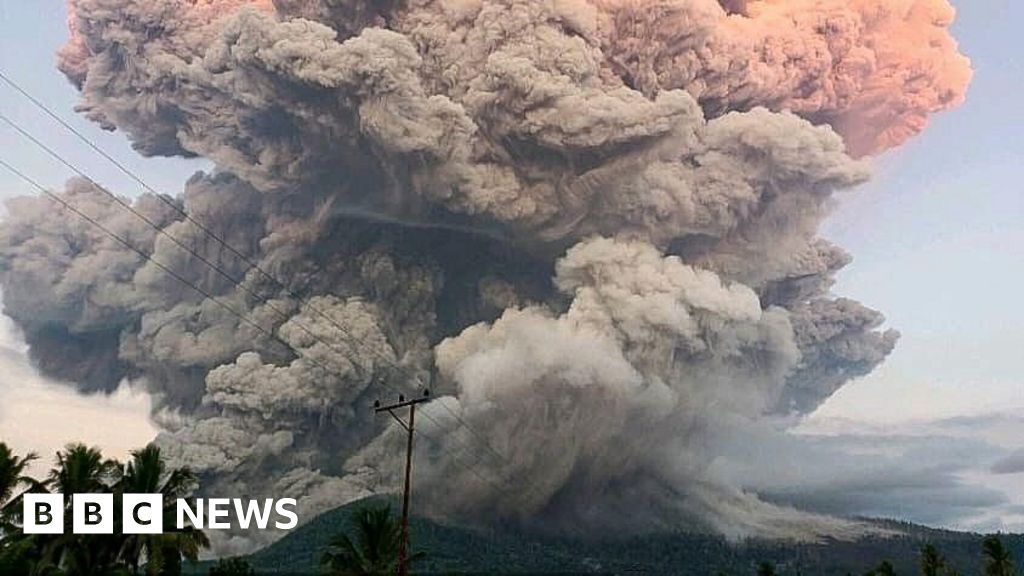What Happened
On June 17, 2025, Mount Lewotobi Laki-laki, one of Indonesia’s most active volcanoes, erupted, sending a massive ash cloud into the atmosphere. The eruption occurred at 17:35 local time (10:35 BST) and was characterized by a plume of ash that reached altitudes of approximately 10,000 meters (32,800 feet) above the volcano’s peak. This event prompted Indonesia’s authorities to issue the highest alert level and establish an exclusion zone of 8 kilometers (5 miles) around the volcano’s crater.
In the aftermath of the eruption, no immediate reports of injuries or significant damage were recorded. However, local officials warned of potential hazards, including lahars—volcanic mudflows that could be triggered by heavy rainfall. Residents in the vicinity were advised to evacuate to safer locations, and precautionary measures, such as wearing face masks to guard against ash inhalation, were recommended. The eruption followed a series of smaller tremors and volcanic activity, indicating ongoing geological instability.
Key Details
- Location: Mount Lewotobi Laki-laki is situated on the island of Flores in southeastern Indonesia.
- Eruption Time: The eruption took place on June 17, 2025, at 17:35 local time.
- Ash Cloud Height: The ash cloud reached heights of 10,000 meters (32,800 feet) and was visible from cities up to 150 kilometers (93 miles) away.
- Exclusion Zone: Authorities established an exclusion zone of 8 kilometers (5 miles) around the volcano.
- Previous Eruptions: The volcano had a significant eruption in November 2024, which resulted in nine fatalities and extensive evacuations.
- Geological Context: Indonesia is part of the Pacific “Ring of Fire,” which is known for its high volcanic and seismic activity, housing 120 active volcanoes.
Multiple Perspectives
Different sources reported on the eruption with varying emphases. The BBC highlighted the immediate safety measures taken by local authorities, including the evacuation of at least one village and the issuance of warnings regarding potential lahars. They noted that the National Disaster Mitigation Agency was actively involved in managing the situation and advising residents.
The New York Times provided a detailed account of the eruption’s visual impact, describing the ash plume as being visible from significant distances and noting the geological indicators that preceded the eruption, such as increased seismic activity. They emphasized the lack of immediate injuries, contrasting this with the fatalities from the previous eruption.
Al Jazeera focused on the broader implications of the eruption within the context of Indonesia’s frequent volcanic activity, reiterating the need for vigilance among residents due to the potential for further eruptions and related hazards. They also noted the historical significance of the volcano’s naming, with “Laki-laki” meaning “man” and its twin, “Perempuan,” meaning “woman.”
Context & Background
Indonesia is an archipelago consisting of over 17,000 islands, making it one of the most volcanically active regions in the world. The country is home to numerous active volcanoes, many of which pose risks to nearby populations. The volcanic activity is primarily due to its location along the Pacific Ring of Fire, where tectonic plates frequently shift, leading to eruptions and earthquakes.
The recent eruption of Mount Lewotobi Laki-laki is part of a pattern of increasing volcanic activity in the region. The November 2024 eruption serves as a stark reminder of the potential dangers posed by these natural phenomena, as it resulted in fatalities and significant disruption. The Indonesian government has established protocols for monitoring volcanic activity and responding to eruptions, which include issuing alerts and coordinating evacuations.
What We Don’t Know Yet
While the immediate impacts of the eruption have been assessed, uncertainties remain regarding the long-term effects on the local environment and communities. It is unclear how the ash fallout will affect air quality and agriculture in the region, as well as the potential for subsequent eruptions. Additionally, while no injuries were reported, the situation could evolve as authorities continue to monitor the volcano’s activity and assess the needs of affected residents.
Further geological assessments will be necessary to understand the implications of this eruption in the context of ongoing volcanic activity in Indonesia. The potential for future eruptions, especially given the seismic activity observed prior to this event, remains a concern for local authorities and residents alike.





